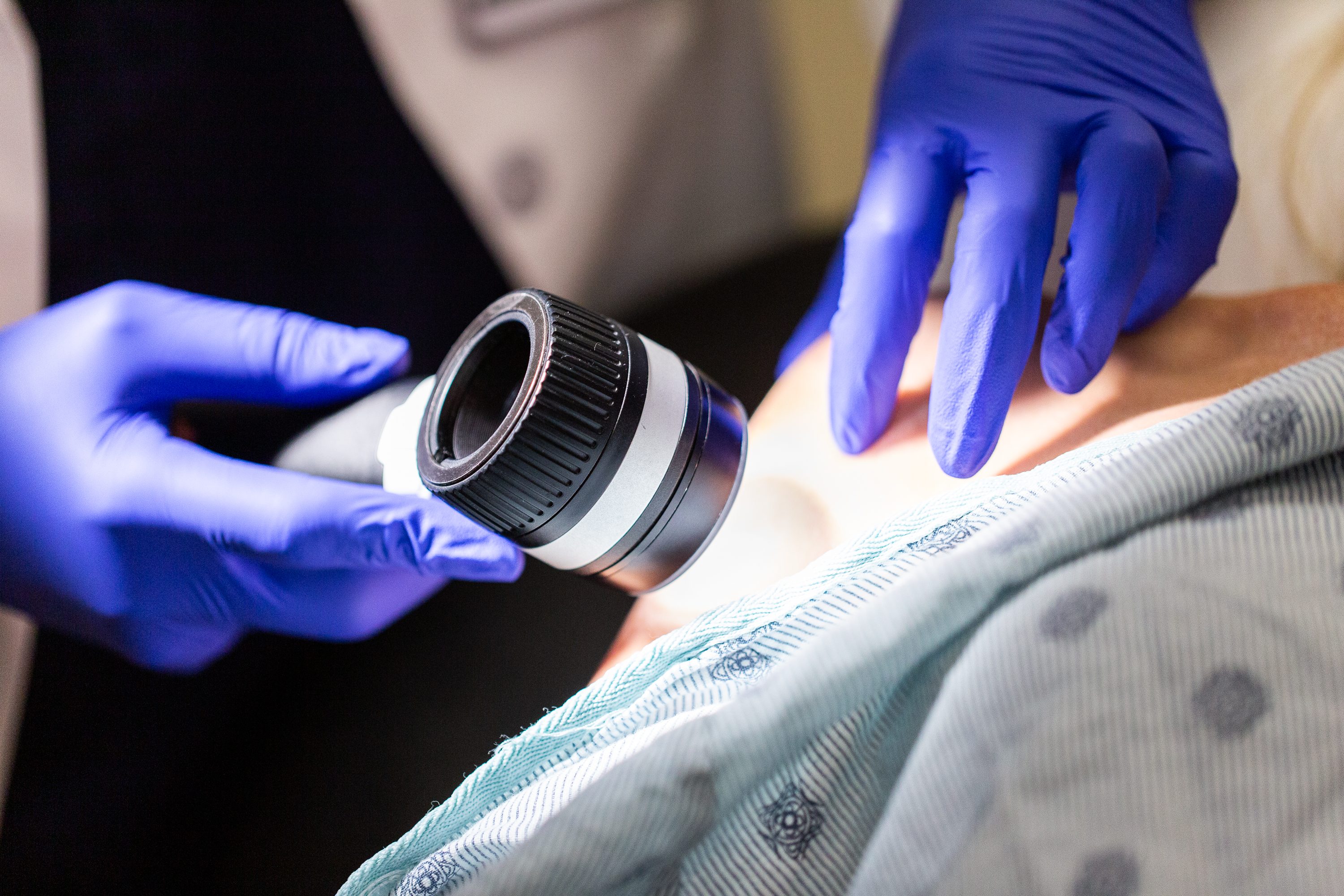request an appointment online.
- Diagnosis & Treatment
- Cancer Types
- Skin Cancer
- Skin Cancer Treatment
Get details about our clinical trials that are currently enrolling patients.
View Clinical TrialsSkin Cancer Diagnosis & Treatment
Your skin cancer treatment at MD Anderson includes a plan customized to your specific type of cancer. Basal and squamous cell skin cancers usually are removed by one of the treatments listed below.
Skin cancer excision
During this procedure, a doctor numbs the diseased area with a local anesthetic and then cuts it out entirely. Typically, a small amount of healthy tissue around the area is removed as well. If the patient has not been previously diagnosed, the tissue is sent to a pathologist, who examines the sample to confirm the diagnosis.
Mohs surgery
During this procedure, a dermatologic surgeon removes a very thin layer of cancer tissue and examines it under a microscope. If skin cancer cells can be seen in the layer, the doctor continues shaving off layers one at a time until no cancer cells are found. This procedure has a very high cure rate and typically results in less scarring than excisions.
Mohs surgery is usually performed at a doctor’s office. The patient’s skin is numbed and occasionally a mild sedative is given. MD Anderson has a Mohs and Dermasurgery Center dedicated to this procedure.
Cryosurgery
Cryosurgery is less invasive than conventional surgery. It is often used to treat actinic keratosis (a precancerous skin condition) and occasionally used for small, newly developed skin cancers.
During this procedure, the doctor uses liquid nitrogen to freeze and destroy diseased tissue. This process may be repeated. Because the doctor can focus cryosurgical treatment on a limited area, the destruction of nearby healthy tissue is typically avoided.
Topical chemotherapy
Chemotherapy drugs work by killing fast-growing cells, such as cancer cells. Skin cancer chemotherapy is delivered as a topical ointment that is applied to the affected skin. At the end of treatment, patients may have redness and some crusting on their skin, which typically heals in two to three weeks. Like cryosurgery, topical chemotherapy it is used to treat actinic keratosis and superficial skin cancers. Cryosurgery is usually limited to small areas, while topical chemotherapy can cover large sections of skin, such as a patient’s entire face.
Laser surgery
Lasers surgery is used to treat precancerous conditions like actinic keratosis and early, superficial skin cancers. During laser surgery, doctors use an intense, focused beam of light to destroy skin cancer.
The laser can be set to remove the skin in controlled layers, depending on the depth of the cancer. The surgeon may remove the top layer only or the top layer plus additional deeper layers.
The laser destruction, plus the body's immune response to the injury, results in a blistered wound that takes several weeks to heal.
Electrodessication and curettage
During this procedure, doctors use a scraping instrument (curette) and electrical currents to destroy and remove small and superficial skin cancers.
High-risk or metastatic skin cancer treatment
When a patient’s skin cancer has spread or is at high risk of spreading, treatment can become more complex. At MD Anderson, these treatment plans are developed by a team of doctors from multiple disciplines, including dermatology, radiation oncology and the different surgical specialties. High-risk skin cancer on the head or neck, for instance, may be treated by a head and neck surgeon. These doctors meet to discuss the patient’s case and work together to develop a treatment plan. Treatments may include surgery, radiation therapy, chemotherapy and more.
Clinical trials
Because of its status as one of the world’s premier cancer centers, MD Anderson participates in many clinical trials for skin cancer. Sometimes they are a patient’s best option for skin cancer treatment.
Learn more about clinical trials.
Learn more about skin cancer:
Treatment at MD Anderson
Basal and squamous cell skin cancers are treated in our Melanoma and Skin Center.
Clinical Trials
MD Anderson patients have access to clinical trials offering promising new treatments that cannot be found anywhere else.
Becoming Our Patient
Get information on patient appointments, insurance and billing, and directions to and around MD Anderson.
Counseling
MD Anderson has licensed social workers to help patients and their loved ones cope with cancer.
myCancerConnection
Talk to someone who shares your cancer diagnosis and be matched with a survivor.
Prevention and Screening
Many cancers can be prevented with lifestyle changes and regular screening.
Help #EndCancer
Give Now
Donate Blood
Our patients depend on blood and platelet donations.
Shop MD Anderson
Show your support for our mission through branded merchandise.


